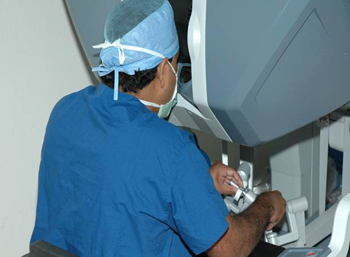Minimally Invasive Pulmonary Care
Our thoracic surgeons are experts in the following minimally invasive surgical techniques for lung diseases:
Studies reveal that combining the benefits of minimally invasive surgery with the expertise and experience of cardiothoracic surgeons results in fewer surgical complications, better outcomes and higher long-term survival rates.
Your UTMB multidisciplinary care team will work together with your surgeons throughout your treatment and keep you informed of all of your treatment options. A multidisciplinary approach to lung disease/cancer care is associated with improved patient outcomes, including a significantly lower risk (70%) of overall complications following surgery, and enables teams of experts to
examine a case from every possible angle.
For more information on lung cancer, please visit:
Minimally Invasive Surgical Approach
Minimally invasive video-assisted thorascopic surgery (VATS) is only performed by 15% surgeons in the U.S. Only 10% of surgeons perform robotic lung resection. Both have been performed at UTMB since 2010.
 Combining technologies of Video Assisted Thorascopic Surgery (VATS) and robotic-assisted surgeries allows surgeons to utilize 3D high-definition technology, improving depth perception, enabling surgeons to clearly visualize critical structures, and giving them full control of the thoracoscope (a fiber-optic camera). The technology allows for precise dissection and manipulation of tissues.
Combining technologies of Video Assisted Thorascopic Surgery (VATS) and robotic-assisted surgeries allows surgeons to utilize 3D high-definition technology, improving depth perception, enabling surgeons to clearly visualize critical structures, and giving them full control of the thoracoscope (a fiber-optic camera). The technology allows for precise dissection and manipulation of tissues.
Minimally invasive surgical procedures require only a number of small incisions and causes less physical injury to the patient’s body, while allowing the surgeon to perform the highly effective procedure. Compared with open surgery, which typically requires four to six weeks of recovery time, patients who undergo the minimally invasive procedure often can return to work and resume other activities as soon as one week after surgery.
In addition, a minimally invasive surgical approach may significantly reduce postoperative pain and need for additional
treatment. Research has demonstrated that postoperative pain measured after more than one year was reduced by 61% with minimally invasive vs. open surgery, as well as a reduction in the total dosage, duration and administration of analgesia.
Delivery of adjuvant chemotherapy may be more feasible after VATS compared to open surgery.